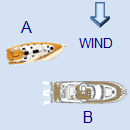Stand on and Give way vessels.
The rules of the road on the water are defined under the collision regulations which are an international set of guidelines so all vessels know what action to take, and what action they expect others to take anywhere in the world. Each maritime nation has enacted legislation that mandates the collision regulations as legally binding.
These rules apply when there is an identified realistic risk of collision. The distance that this applies varies between vessels and so for ships, action may need to be taken when you are still over a nautical mile apart, however for recreational vessels that are more manoeuvrable, this distance may only be a few hundred metres.
Here are some common right of way rules:
In the following situations two vessels are on a collision course. Which
is the give way vessel and what action should be taken?
Think through the reasoning behind each rule and what could happen if the give way vessel did a different action to what was expected.
In each of the scenarios, the vessels have been squashed together for display, however it is safe to assume that there is sufficient room for vessels to manoeuvre, and keep clear.

Vessel B is a motor vessel, and vessel A is a yacht under sail. Power gives way to sail.
Vessel B gives way to Vessel A and alters course to starboard and passes behind vessel A.
Vessel A is expected to maintain course while B keeps clear, however A should be prepared to take avoiding action if B does not alter course.

Vessel A is on the starboard side of vessel B and there fore is the stand on vessel, and B is expected to alter course.
Vessel B gives way to A and alters course to starboard to pass behind vessel A.

Both vessels are under sail and the windward vessel is expected to keep clear. Vessel A is to windward and is required to give way to vessel B.
Vessel A should reduce speed and steer behind vessel B.

When two vessels meet head to head, both vessels are required to alter course to starboard and pass each other port side to port side.
A gives way to B and alters course to starboard.

For two sailing vessels that meet on opposing tacks, the vessel that is on port tack gives way to the vessel on starboard tack.
Vessel A is on port and is required to give way to vessel B.
Vessel A can either turn to starboard and go behind vessel B, or to turn to port and tack over on to starboard provided that vessel A is clear of vessel B and does not interfere with them holding course.

Overtaking vessel must keep clear. Although A is a sailing vessel, when it is overtaking a power boat, it is required to keep clear. It would be a bit much to ask every power boat to look behind them to give way to a sailing boat that is about to overtake them.
With the advent of hyrdo-foiling sail boats, it has become very common for a sailing boat to overtake a powerboat.
Vessel A gives way to B.
For a sailboat that is overtaking a power boat, the sailboat should decide their preferred side to overtake depending on the wind and weather conditions.